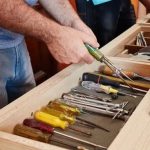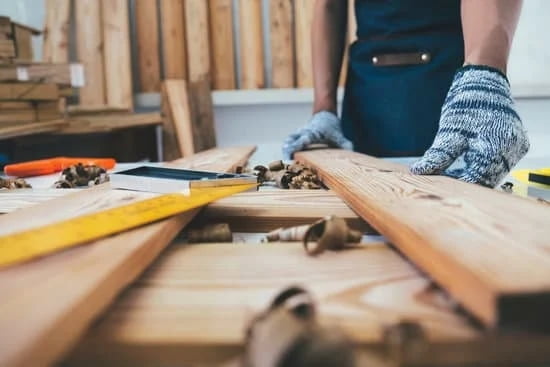Woodworking vices are an essential tool in any woodworker’s arsenal, providing stability and grip to hold workpieces in place during cutting, drilling, or shaping. Knowing where to put woodworking vise is crucial to optimizing its functionality and efficiency in your workshop. Whether you are a seasoned craftsman or a beginner enthusiast, having a reliable vise can make a significant difference in the quality of your work.
When it comes to woodworking vises, there are various types to choose from, including bench vises, front vises, and end vises. Each type offers different features and advantages, catering to specific woodworking needs. Understanding the differences between these vices can help you determine which one is best suited for your projects and workspace layout.
In this article, we will delve into the factors to consider when deciding where to place your woodworking vise. From the size and stability of your workbench to the materials used in its construction, every detail plays a crucial role in creating an efficient and ergonomic work environment. By taking these factors into account, you can ensure that your vise is positioned at the optimal height and angle for comfortable working conditions.
Types of Woodworking Vises
Woodworking vises are essential tools in any woodworking workshop, providing a secure grip on your workpiece to ensure precision and safety during various projects. There are different types of woodworking vises available, each with its own unique features and advantages. Understanding the differences between bench vises, front vises, and end vises can help you choose the right type for your specific needs.
Here are some common types of woodworking vises to consider:
- Bench Vises: Bench vises are typically mounted underneath or on top of the workbench surface. They are versatile and can be used for a wide range of woodworking tasks, from holding small pieces for intricate detail work to securing larger materials for more robust projects.
- Front Vises: Front vises are designed to be mounted on the front edge of the workbench, allowing for easier access and better visibility while working on your project. They provide a strong grip and stability, making them ideal for tasks that require controlled clamping pressure.
- End Vises: End vises are installed at one end of the workbench and are particularly useful for holding long pieces of wood or other materials securely in place. They can be adjusted to accommodate different lengths and thicknesses, making them versatile options for various woodworking projects.
When deciding where to put your woodworking vise in your workshop, it is important to consider factors such as the size, stability, and material of your workbench. The location should provide easy accessibility and comfortable working conditions. Additionally, considering the height and angle at which the vise is placed can significantly impact ergonomics and overall efficiency while working on your projects.
Remember that proper installation is key when setting up your woodworking vise. Whether you choose to mount it on the front edge or side of your workbench or opt for a portable vise that can be easily moved around as needed, following manufacturer instructions and ensuring secure attachment will guarantee safe and effective use. Take time to maintain your vise regularly by keeping it clean, lubricated, and free from debris to prolong its lifespan and performance in your workshop.
Factors to Consider
When determining where to put a woodworking vise in your workshop, there are several important factors to consider. One of the key considerations is the size of your workbench. The vise should be mounted in a location where it does not obstruct other tools or impede your movement around the workspace. Additionally, the stability of the workbench is crucial to ensure that the vise can securely hold your workpieces without wobbling or shifting during use.
The material of your workbench also plays a significant role in determining where to place the woodworking vise. If you have a wooden workbench, you may need to reinforce the area where the vise will be mounted to ensure it can withstand the clamping pressure applied during woodworking tasks. On the other hand, if you have a metal workbench, you may need specialized hardware or adapters to securely attach the vise.
Moreover, when deciding on the placement of your woodworking vise, it is essential to take into account the type of projects you typically work on. For example, if you frequently handle large or heavy materials, you might want to position the vise closer to one end of the workbench for better support and leverage.
Conversely, if you often work on smaller intricate pieces, placing the vise towards the center of the bench may provide more versatility and accessibility. Ultimately, considering these factors will help you determine where to put your woodworking vise for optimal functionality and efficiency in your workshop.
Ergonomics
When setting up a woodworking vise in your workshop, it is crucial to consider ergonomics to ensure comfortable working conditions. The height and angle at which the vise is placed can greatly impact your posture and overall experience while working on your projects. Ideally, the vise should be positioned at a height that allows you to work without straining your back or shoulders for prolonged periods.
To determine the best height for your woodworking vise, consider the tasks you will be performing most frequently. If you will be doing a lot of detail work that requires precision, having the vise slightly higher may be beneficial.
On the other hand, if you will be exerting a lot of pressure while working, a lower placement might provide better leverage. Experimenting with different heights and angles before securing the vise can help you find the most comfortable position for your specific needs.
In addition to height, the angle of the woodworking vise also plays a significant role in maintaining proper posture and reducing strain on your body. Positioning the vise at an angle that allows for natural movement of your arms and wrists can prevent fatigue and discomfort during long hours of woodworking. Consider factors such as whether you are left or right-handed, as this might influence where you want to place your woodworking vise to maximize efficiency and comfort.
| Factors | Consideration |
|---|---|
| Height | Determine tasks performed frequently & experiment with different heights |
| Angle | Position at an angle for natural arm & wrist movement based on dominant hand |
Placement Options
When it comes to setting up your woodworking vise, choosing the right placement is crucial for maximizing its utility in your workshop. Depending on the type of projects you work on and the space available in your workspace, there are various options for where to put your vise. Here are some placement options to consider:
- Mounting the vise on the front of the workbench: This is a common choice for many woodworkers as it allows for easy access and provides ample support for securing workpieces. Having the vise at the front also ensures that you have enough space around the bench to maneuver while working on your projects.
- Mounting the vise on the side of the workbench: Placing the vise on the side of the bench can be a great option if you need to secure longer or irregularly shaped pieces of wood. This positioning allows for greater flexibility in clamping different sizes of materials without obstruction from the bench itself.
- Using a portable vise: If you have limited space or prefer to have more versatility in where you can work, investing in a portable vise is an excellent choice. These vises can be attached to various surfaces such as sawhorses or countertops, providing flexibility in positioning and allowing you to move your workspace as needed.
Consider factors such as the size of your workbench, the types of projects you typically work on, and how much mobility you require when deciding where to install your woodworking vise. By carefully evaluating these aspects, you can determine which placement option will best suit your needs and make your woodworking tasks more efficient.
Remember that regardless of where you choose to put your woodworking vise, ensuring that it is securely installed and stable is essential for safe and effective use. Following proper installation guidelines and regularly maintaining your vise will help prolong its lifespan and maximize its performance in all your woodworking endeavors.
Tips for Installation
When it comes to setting up your woodworking vise in the workshop, proper installation is key to ensure efficient and safe use. Here are some tips on how to install and secure your woodworking vise in your desired location.
Choose the Right Location
Before installing your woodworking vise, consider where you will be doing most of your work and which part of the workbench would provide the most convenience. Depending on the type of projects you’ll be working on, you may want to place the vise closer to the edge or in the center of the bench. Make sure there is enough space around the vise for maneuvering wood pieces comfortably.
Mounting Options
There are different mounting options for woodworking vises, including front-mounted, side-mounted, or even using a portable bench vise. Front-mounted vises are commonly used for easy access and versatility, while side-mounted vises are ideal for longer pieces of wood that need extra support. Portable bench vises can be clamped onto any sturdy surface and offer flexibility in terms of placement.
Securing the Vise
Once you have decided on the location and mounting option, it’s time to secure the vise in place. Use sturdy bolts or screws to attach the vise to the workbench securely. Make sure to tighten them properly to prevent any wobbling during use. Test the vise by clamping a piece of scrap wood and applying pressure to ensure it’s firmly attached before starting any woodworking projects.
By following these tips for installation, you can set up your woodworking vise in a way that enhances your workflow and provides maximum convenience while working on various projects. Remember that proper installation not only ensures safety but also allows you to make full use of your woodworking tools without any hindrances.
Maintenance
Woodworking vises are essential tools in any workshop, providing a secure grip on workpieces during various woodworking tasks. Proper maintenance of your vise is crucial to ensure its longevity and efficient performance.
One of the key aspects of caring for your vise is keeping it clean and free from dust, debris, and any build-up of materials that could affect its smooth operation. Regularly wiping down the jaws and screw threads with a clean cloth can help prevent any particles from interfering with the vise’s functionality.
In addition to keeping your woodworking vise clean, it is essential to periodically lubricate the moving parts to maintain smooth operation. Applying a small amount of lubricant, such as machine oil or grease, to the screw threads and pivot points can help prevent rusting and ensure that the vise operates smoothly. Be sure to wipe off any excess lubricant to avoid attracting more dust and debris.
Another important aspect of vise maintenance is checking for any signs of wear or damage. Inspect the jaws, screws, handle, and any other moving parts regularly for signs of wear or misalignment.
If you notice any issues, such as loose components or damaged parts, it is important to address them promptly to prevent further damage and maintain the vise’s functionality. Knowing where to put woodworking vise doesn’t just stop at installation but also extends to proper care and maintenance to keep it in good working condition for years to come.
| Importance | Maintenance Tips |
|---|---|
| Essential tool in workshop | Keep vise clean from dust & debris |
| Longevity & efficient performance | Regular lubrication of moving parts |
| Prevent rusting & smooth operation | Inspect for wear or damage periodically |
Creative Ways to Utilize the Vise
Woodworking vises are incredibly versatile tools that can be utilized in a variety of creative ways to enhance your projects and woodworking experience. One innovative way to maximize the use of your vise is by incorporating it into your wood carving projects.
By securely clamping your workpiece in the vise, you can have both hands free to focus on intricate carving details without worrying about the piece moving or slipping. This not only improves precision but also adds an extra layer of safety to your woodworking process.
Another creative way to utilize your woodworking vise is by turning it into a makeshift assembly tool for glue-ups. By using the vise to secure pieces together while the glue dries, you can ensure a tight bond and accurate alignment without having to hold everything in place manually. This method is especially helpful when working on complex joinery or delicate projects where even the slightest movement can affect the final outcome.
Additionally, woodworking vises can be used as a support system for sanding projects. By firmly securing your workpiece in the vise, you create a stable platform for sanding, allowing you to focus on achieving smooth and even surfaces without the risk of slippage.
This technique is particularly useful for smaller pieces or detailed areas that require precise sanding control. Overall, by thinking outside the box and exploring different ways to incorporate your woodworking vise into various aspects of your projects, you can elevate your craftsmanship and efficiency in the workshop.
Conclusion
In conclusion, having a woodworking vise in your workshop is essential for any woodworking enthusiast. Whether you are a beginner or a seasoned craftsman, the right vise can make a significant difference in the quality of your work and overall efficiency. By understanding the various types of woodworking vises available, considering important factors like size and material of your workbench, and paying attention to ergonomics, you can ensure that your vise is optimally placed for your comfort and convenience.
When deciding where to put your woodworking vise, it is crucial to take into account not only the practicality but also the safety aspects of its placement. Whether you choose to mount it on the front or side of your workbench, or opt for a portable vise that can be easily moved around, make sure that it is securely installed so as not to compromise your work or pose any risk of accidents.
Following the tips for installation provided in this guide will help you set up your vise properly and get the most out of its functionality.
In essence, finding the ideal location for your woodworking vise involves careful consideration of multiple factors such as workspace layout, project requirements, and personal preferences. By following the advice outlined in this article and experimenting with different placement options, you can find where to put a woodworking vise that best suits your needs and enhances your woodworking experience. So don’t hesitate to explore creative ways to utilize your vise and enjoy the benefits it brings to your craftmanship journey.
Frequently Asked Questions
What Is the Best Position for a Workbench Vice?
The best position for a workbench vice is typically on the front edge of the workbench, allowing for easy access and maneuverability when working on projects. Placing it in a sturdy and secure position will ensure stability while using it for various tasks.
How Should a Woodwork Vice Be Used?
When using a woodworking vice, make sure to secure the workpiece firmly between the jaws before starting any cutting, shaping, or sanding. Adjust the vice to hold the piece securely without damaging it. Remember to use appropriate pressure without over-tightening.
Do I Need a Vise on My Workbench?
Whether you need a vice on your workbench depends on the type of projects you plan to work on regularly. A vise can be extremely helpful for holding pieces steady during cutting, shaping, or detailing tasks. It adds stability and safety to your woodworking projects when properly used.

Hi everyone! I’m a woodworker and blogger, and this is my woodworking blog. In my blog, I share tips and tricks for woodworkers of all skill levels, as well as project ideas that you can try yourself.





